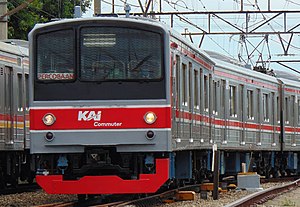| KRL Commuterline | |||
|---|---|---|---|
 | |||
 KRL 205 series (M17) arriving at Manggarai station | |||
| Overview | |||
| Native name | Kereta Rel Listrik (KRL) Commuter Line/Jabodetabek | ||
| Owner | |||
| Area served | Greater Jakarta | ||
| Locale | Jakarta, Indonesia | ||
| Transit type | Commuter rail | ||
| Number of lines | 5 | ||
| Number of stations | 83 (operational) 4 (under construction) | ||
| Daily ridership | 1.2 million (highest)[1] 862,000 (average) | ||
| Annual ridership | 156.82 million (Jan - Jun 2024)[2] | ||
| Headquarters | Juanda Station 2nd floor, Sawah Besar, Jakarta, Indonesia | ||
| Website | commuterline | ||
| Operation | |||
| Began operation |
| ||
| Operator(s) | KAI Commuter | ||
| Number of vehicles | see below | ||
| Train length | 8, 10 or 12 cars per trainset | ||
| Headway | 3 minute(s)– 1hour (Some routes) | ||
| Technical | |||
| System length | 293.4 km (182.3 mi)[3] | ||
| Track gauge | 1,067 mm (3 ft 6 in) Cape gauge | ||
| Electrification | 1,500 V DC overhead catenary | ||
| Top speed | 95 km/h (59 mph) | ||
| |||

KRL Commuterline, commonly known as Greater Jakarta Commuter rail, Jakarta Commuter rail, and KRL Commuter Line Jabodetabek is a commuter rail system for Greater Jakarta in Indonesia. It was previously known as KRL Jabodetabek. It is operated by KAI Commuter (KCI), a subsidiary of the Indonesian national railway company PT Kereta Api Indonesia (KAI). The rail system uses rolling stock of rapid transit standard and operates high frequency services with minimum headway. In 2019, the average number of Commuterline users per day reached 1.04 million, with the record of the highest number of users served in a day being 1,154,080.[4][5][6]
"KRL" itself stands for "Kereta Rel Listrik" (literally "electric rail train" or "electric railcar"), a term for an electric multiple unit train.
- ^ "Pengguna KRL Jabodetabek Disebut Capai 1,2 Juta Orang Per Hari". 19 June 2022. Archived from the original on 3 February 2023. Retrieved 24 August 2022.
- ^ Erlina Santika (15 January 2024). "KRL Commuter Jabodetabek Sumbang 290 Juta Penumpang pada 2023". kompas (in Indonesian). Archived from the original on 24 June 2024. Retrieved 24 June 2024.
- ^ "Tahun Ini, KRL Commuter Line Bidik 1,2 Penumpang/Hari" (in Indonesian). CNBC Indonesia. 10 March 2019. Archived from the original on 15 April 2019. Retrieved 18 March 2019.
- ^ "Info Perusahaan". Archived from the original on 13 April 2021. Retrieved 29 October 2009.
- ^ Agustin Setyo Wardani (3 February 2015). "2014, Sebanyak 200 Juta Orang Naik Kereta Jabodetabek". Archived from the original on 3 February 2015. Retrieved 3 February 2015.
- ^ Fajarta, Carlos Roy (20 November 2019). "Commuter Line Passes Milestone of 1m Daily Passengers". Jakarta Globe. Archived from the original on 20 October 2022. Retrieved 21 November 2019.
